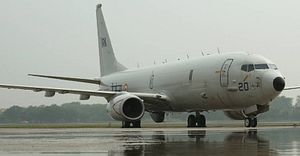On November 13, India’s Defense Minister Manohar Parrikar officially inducted the Indian Navy’s first squadron of Boeing P-8I Poseidon aircraft at Rajali Naval Air Station in southern India, about 70 kilometers off Chennai.
According to a press release from the Indian Navy, the Indian defense minister flew in on board a P-8I Poseidon aircraft prior to attending the official ceremony. “During the flight, Shri Parrikar was given an exposure to various sensors and other sophisticated state-of-the-art equipment and their capabilities,” the press statement reads.
In his remarks, Parrikar pointed out that even during the extensive trial and testing phases the P-8I aircraft had “achieved a number of operational milestones” including “participation in the search effort for Malaysian Airlines Flight MH 370, the first successful firing of air launched Harpoon Block II missile in the world, torpedo firing, and active participation in major naval exercises.”
The new unit — designated Indian Naval Air Squadron 312-A — will be permanently based at Rajali Naval Air Station.
In January 2009, India became the first international customer for the P-8I aircraft, designed and built by Boeing to replace the U.S. Navy’s aging P-3 fleet, with the signing of a $2.1 billion contract for the purchase of eight aircraft.
According to my colleague, Ankit Panda, the P-8I is an export variant of the P-8A Poseidon, “designed for the needs of the Indian Navy. Notably, it features a Telephonics APS-143 OceanEye aft radar, and magnetic anomaly detector not present on the original P-8A.”
The aircraft is capable of flying 1,100 kilometers to a patrol area, remaining there for six hours, and then returning to base, with a total mission time of ten hours, according to The Business Standard.
The first plane was delivered to India in May 2013. All eight planes are currently operational and have been inducted into the Indian Navy. The Indian Navy’s press release explains that the P-8I aircraft “is equipped for long range anti-submarine warfare, anti -surface warfare, intelligence, surveillance and reconnaissance in support of broad area, maritime and littoral operations. Its communication and sensor suite includes indigenous equipment (…)”
Business Standard discusses in detail the P-8I’s formidable anti-ship weapons:
Enemy submarines can be destroyed with five Mark 54 torpedoes housed in a special warmed compartment in the aircraft’s belly, from where they are launched. Submarines can also be engaged with the Mark 82 depth charge, which is standard U.S. Navy equipment. Alternatively, the P-8I, which is data-linked with Indian submarines, can pass on the location of the enemy submarine. Indian submarines can then zero-in on the intruder and fire torpedoes to destroy it.
In July, India announced that it will acquire four additional P8-I aircraft from the United States. Once the additional aircraft are delivered, India plans to retire its aging fleet of five Russian Tu-142 Bear long-range maritime surveillance aircraft.
































